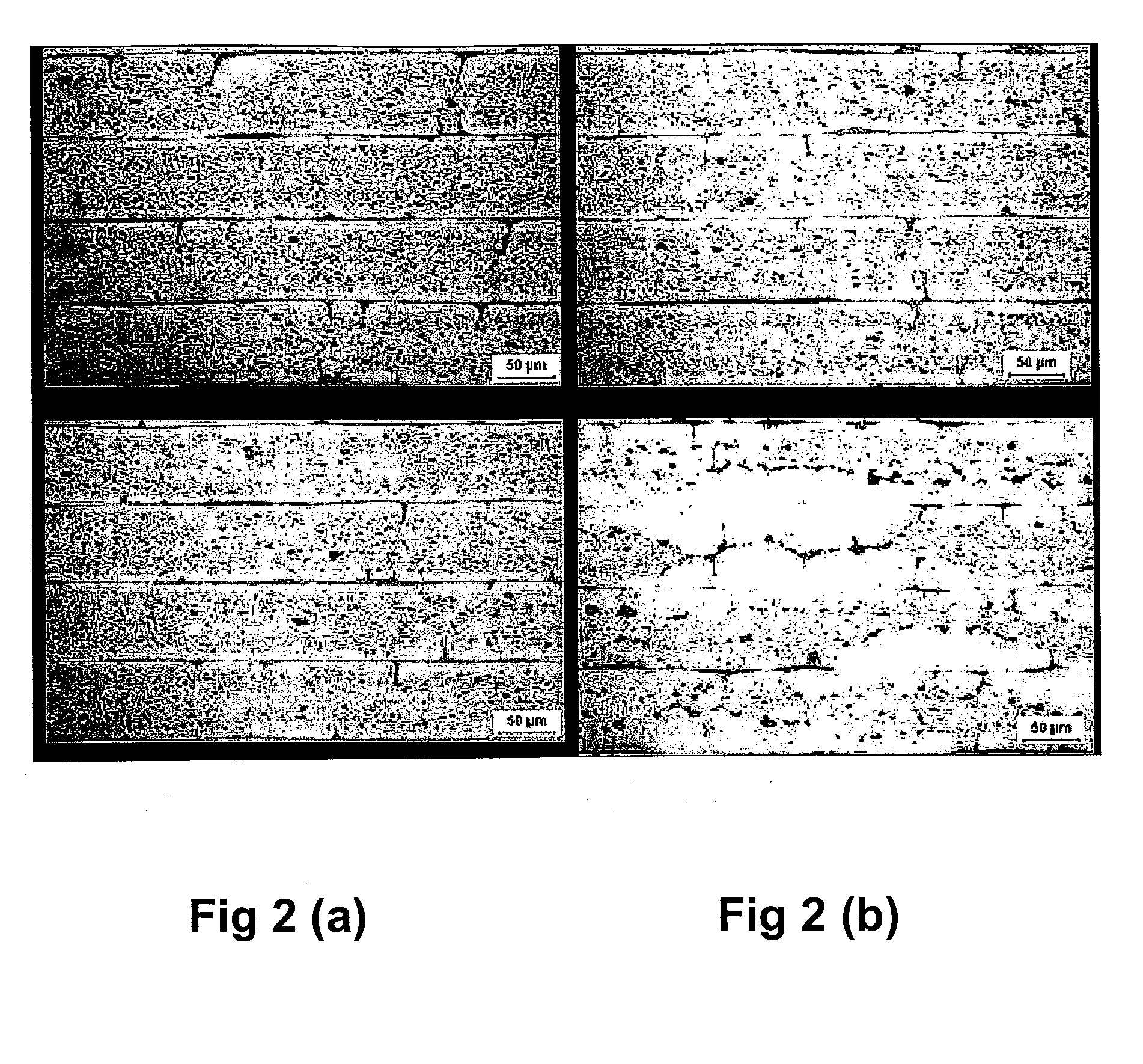High strength and sagging resistant fin material
- Summary
- Abstract
- Description
- Claims
- Application Information
AI Technical Summary
Problems solved by technology
Method used
Image
Examples
example 1
[0034]Two ingots of material A1 and A2 with a composition of 0.8-0.9% Si, 0.2% Fe, 1.6% Mn, 0.11-0.12% Zr, 1.5-1.6% Zn and other elements each less than 0.05% were DC-cast pre-heated below 550° C. and hot rolled with a total hot reduction of 99% prior to cold rolling. Material A1 was directly cold rolled to final gauge and annealed at different temperatures. Some material was fully soft annealed to 0 temper, some was recovery annealed to H24 temper and some was not annealed at all giving H18 temper. Material A2 was recrystallisation annealed before final cold rolling to H14 temper. All samples were exposed to a heat treatment to simulate brazing at 600° C.
[0035]The properties are shown in Table 1.
[0036]The sagging resistance was measured according to the following method: The material is mounted in a special rig as shown in FIG. 1. Samples 15 mm wide were cut across the rolling direction and at least 90 mm along the rolling direction. Four samples were mounted in the rig. The cantil...
example 2
[0040]Three ingots from the very same charge, with composition of 0.8% Si, 0.2% Fe, 1.6% Mn, 0.12% Zr, 1.6% Zn and other elements each less than 0.05%, were pre heated at different temperatures prior to hot rolling to improve the delivery formability and sagging resistance during brazing. The final temperatures and total heating times for the different ingots were for B1-457° C. / 11 hours, B2-490° C. / 15 hours, B3-540° C. / 21 hours. The materials were hot rolled, cold rolled and recovery annealed to H24 temper. The properties of 0.1 mm final strip are given in Table 2.
TABLE 2Properties measured for material B. The sagging resistance was measuredusing a cantilever beam length of 60 mm.Pre heatingSaggingTemp / totalAs deliveryAs deliverydistanceMaterialtimeRp0.2 [MPa]A50mm [%][mm]B1457° C. / 11 hours1843.822B2490° C. / 15 hours1756.818B3540° C. / 21 hours1974.430
[0041]The results show that there is an optimum temperature and time for preheating prior to hot rolling to achieve the best combinatio...
example 3
[0042]The effect of delivery temper was investigated on braze clad strip of a material C with following composition:
[0043]Core Mn=1.6%, Si=0.8%, Fe=0.2%, Zn=1.5%, Zr=0.11%, other elements each less than 0.05%. Braze clad Si=7.7%, Fe=0.1%, other elements each less than 0.05%. The material is clad with 10% on each side. Cladding was carried out during hot rolling.
[0044]The material was DC-cast, followed by pre heating below 550° C., hot rolling to 4 mm and cold rolling to 0.10 mm final thickness. The material in H14 condition was fully soft annealed at 0.17 mm intermediate gauge. All samples in this example are taken from the identical mother coil. The different samples could be taken by splitting the coil in different parts.
[0045]To measure the particle density of the material sections were cut in the longitudinal, ND-RD, plane of the strip. The sections were mechanically polished using Struers OP-S suspension, containing 0.04 μm colloidal silica, in the last preparation step. The ar...
PUM
| Property | Measurement | Unit |
|---|---|---|
| Temperature | aaaaa | aaaaa |
| Temperature | aaaaa | aaaaa |
| Temperature | aaaaa | aaaaa |
Abstract
Description
Claims
Application Information
 Login to View More
Login to View More - R&D
- Intellectual Property
- Life Sciences
- Materials
- Tech Scout
- Unparalleled Data Quality
- Higher Quality Content
- 60% Fewer Hallucinations
Browse by: Latest US Patents, China's latest patents, Technical Efficacy Thesaurus, Application Domain, Technology Topic, Popular Technical Reports.
© 2025 PatSnap. All rights reserved.Legal|Privacy policy|Modern Slavery Act Transparency Statement|Sitemap|About US| Contact US: help@patsnap.com


